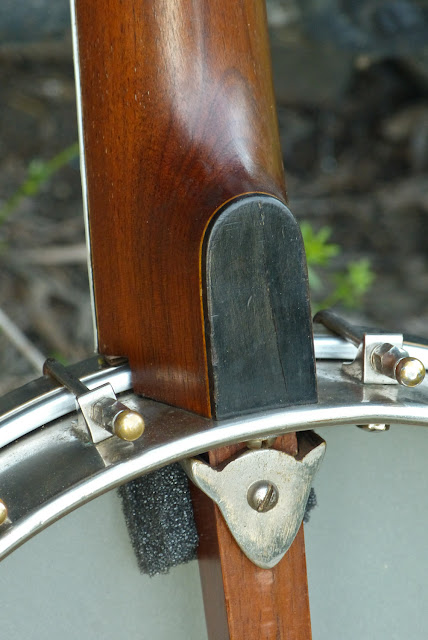1900s Unmarked Fancy 5-String Openback Banjo
This banjo is unmarked but I'm pretty sure it was made by Lange in New York right after the factory changed over from the old Buckbee ownership. It has many similarities to other off-brand Lange products and it's obviously a well-built machine. Still, I'm not certain -- so if you have a lead, please tell me.
What I do know is that it came by way of a consignor and I've done a bunch of work to get it up to snuff -- a fret level/dress, replacement rim hardware, a new head, bridge, new geared tuners, much cleaning, and a good setup with nylon strings. When this was made it was probably intended for gut and the nylon feels more appropriate. The banjo could probably handle light steel (9s), however, though I don't think this style of build sounds best with steel.
It's a full-scale (26"), standard-size (11" rim) banjo and is built with nice materials and has excellent inlay and trim. I've set it up on-the-dot at 3/32" overall at the 12th fret. Steel could use a slightly lower bridge to get 1/16" overall. I think fingerpickers and "classic" style players will enjoy this style of banjo most, as (true to most during the time) it doesn't have an unfretted or "scooped" area to suit a real clawhammer "banger." Tonally it's clean, clear, up-front, and unafraid of shining. It's got a nice "cut."
If I can use them, I often prefer Elite-branded Remo Renaissance heads for their simple looks and good, clean tone.
The pearl inlay is fantastic. Note the nice, thick, ebony headstock veneer.
The fretboard is stained maple, however. The neck is also perfectly straight and the frets are all in good order. I re-used a mix of antique and original-to-the-banjo buttons when I added the new tuners. that requires a bit of modification but I think it's worth it to maintain a more vintage look. I know my customers appreciate the 4:1+ ratio of the geared banjo pegs, too. Friction pegs can be a pain.
As usual, I've used an all-maple "minstrel-style" banjo bridge to get the most projection/oomph out of the light nylon strings.
The neck and dowel are mahogany and this has a nice, medium-sized soft-V shape that feels sturdy and dependable.
The rim's nickel-plated cladding is curled-over a brass hoop on both the top and bottom edges. This stiffens the rim and also makes an integral "tonering."
Most of the hardware is entirely original, though on the "knee" side of the rim I've replaced 6 of the hook/nuts with period, but different, hardware. One shoe is also replaced.
That tailpiece appears to be a late-20s or early-30s unit rather than an original one. I would've expected a No-Knot or similar on here. This banjo can date anywhere from around 1890 to 1910 per its build, but is probably from right around 1900.
I added a pad of foam to cut down on overtones and converted the neck-join from a neck brace+shims to a simple single bolt attachment. I've left the original neck brace in place (the bit on the dowel) just for looks.
I find that most of my customers are driven crazy by shim-style neck braces (the shims fall out after a while and then the action gets high/off), so I've been using old screws and simply bolting the necks if the neck brace isn't up to snuff for modern players' expectations of the instruments. It's simple... and works very well. Buckbee used the attachment style on almost all of their instruments and Gibson, via its coordinator rod bolting at the heel, made the same idea basically the standard-issue solution.























Comments